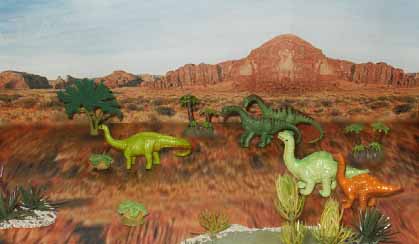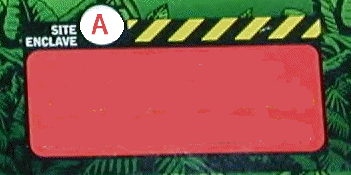LATE JURASSIC MORRISON FORMATION
Diplodocids.
updated 060412
Mouse over the graphics for more figure info.
Morrison diplodocids Suuwassea, Apatosaurus, Supersaurus, Diplodocus, Seismosaurus, and Barosaurus. Related animals are found in Europe and Africa.
 Diplodocids were relatively slender but extremely long. They had short legs, their rear legs were longer than front legs, giving their back a distinctive downward slope towards the neck. In the early 1990s, a diplodocid specimen was described with a row of keratinous (horny, not bony) spines running down the base of the tail . Further finds have shown that rather than forming a spiny ridge down the back , these spines were more uniformly distributed and Diplodocus over the animal's torso. Spines may have been a common feature among diplodocids.
Diplodocids were relatively slender but extremely long. They had short legs, their rear legs were longer than front legs, giving their back a distinctive downward slope towards the neck. In the early 1990s, a diplodocid specimen was described with a row of keratinous (horny, not bony) spines running down the base of the tail . Further finds have shown that rather than forming a spiny ridge down the back , these spines were more uniformly distributed and Diplodocus over the animal's torso. Spines may have been a common feature among diplodocids.
 Diplodocids also had long, whip-like tails, which were thick at the base and tapered off to be very thin at the end. Heads, like those of other sauropods, were tiny with the nasal openings on the top of the head (though in life the nostrils themselves would have been close to the tip of the snout). Their teeth were only present in the front of the mouth, and looked like pencils or pegs. They probably used their teeth to crop off food, without chewing, and relied on gastroliths (gizzard stones) to break down tough plant fibers. They disappear from Laurasia durring the Early Jurassic.
Diplodocids also had long, whip-like tails, which were thick at the base and tapered off to be very thin at the end. Heads, like those of other sauropods, were tiny with the nasal openings on the top of the head (though in life the nostrils themselves would have been close to the tip of the snout). Their teeth were only present in the front of the mouth, and looked like pencils or pegs. They probably used their teeth to crop off food, without chewing, and relied on gastroliths (gizzard stones) to break down tough plant fibers. They disappear from Laurasia durring the Early Jurassic.
